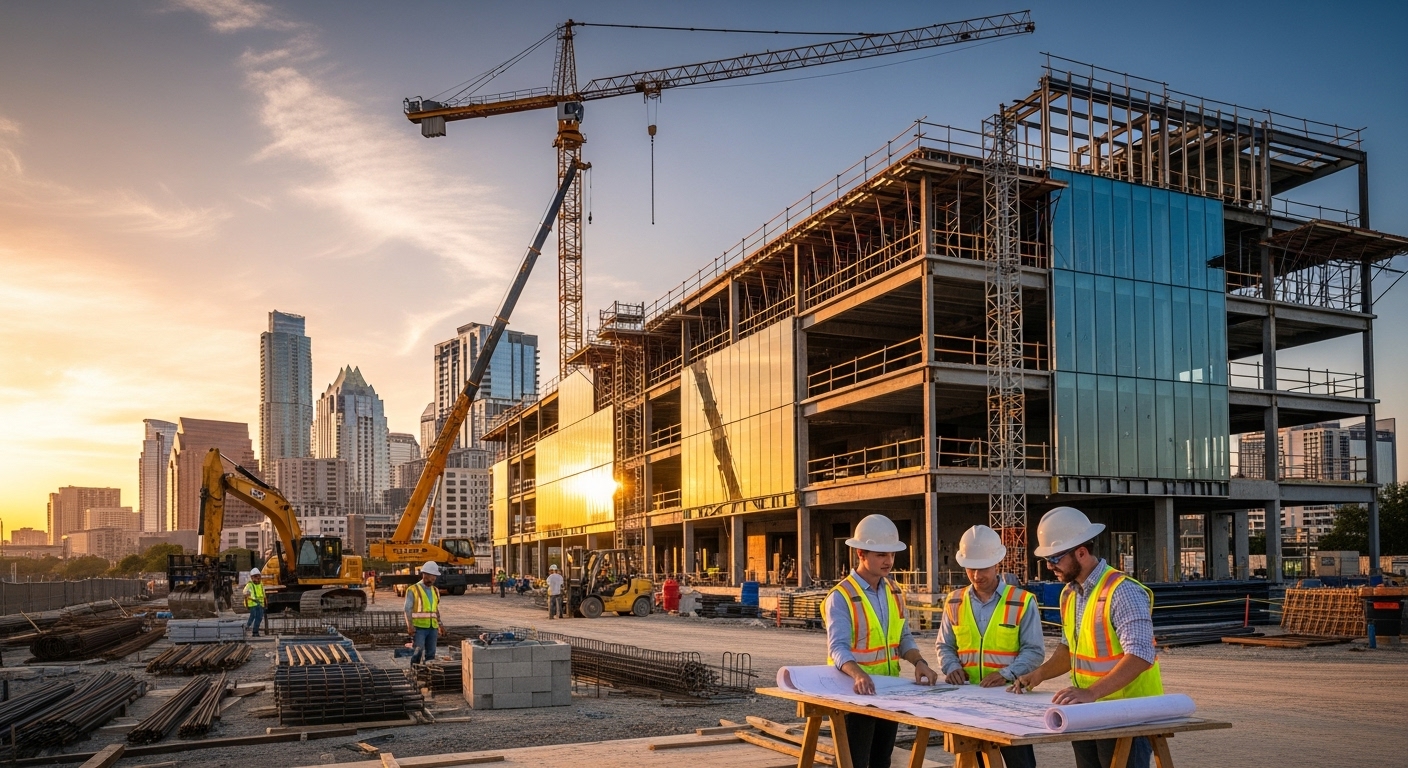I’ll create a comprehensive SEO blog post targeting architectural and design-build firms in Austin who need construction execution support. Let me first gather some additional context about the current Austin construction market and then craft the article.Now I’ll create a comprehensive SEO blog post targeting architectural and design-build firms in Austin, focusing on construction execution support and incorporating the research data I’ve gathered.
The Future of Design-Build Partnerships: How Austin’s Construction Boom is Reshaping Collaborative Project Delivery
Austin’s construction landscape is experiencing unprecedented transformation in 2025. With over $10 billion in active projects and 11 major megaprojects planned through 2031, the city has become a focal point for innovative construction partnerships. For architectural and design-build firms, this growth presents both tremendous opportunities and complex execution challenges that require strategic construction collaboration.
Austin Leads the Texas Construction Renaissance
The Austin metropolitan area has emerged as the epicenter of Texas construction innovation. Recent market analysis reveals that Austin ranks second nationally for office development, while simultaneously leading in mixed-use and sustainable construction projects. This dual focus on commercial and residential development has created a unique ecosystem where architectural firms must navigate increasingly complex project requirements.
Record-Breaking Market Performance
Austin’s construction sector is experiencing record-breaking growth, with several key indicators pointing to sustained expansion:
- 11 megaprojects currently in development, including Northline, The Railyard, and Uptown ATX
- $105 million investment in new life sciences facilities at EastVillage
- 223,000 square feet of specialized construction space fully pre-leased to major tech companies
- Continuous pipeline of mixed-use, office, multifamily, and retail projects extending to 2031
This volume of activity has created significant demand for construction execution partners who understand both the technical requirements and the collaborative nature of modern project delivery.
The Evolution of Design-Build Partnerships in Central Texas
Traditional project delivery methods are giving way to more integrated approaches that emphasize collaboration from concept to completion. Austin’s leading projects demonstrate how design-build partnerships can accelerate timelines while maintaining quality standards that meet both investor expectations and community needs.
Key Advantages of Collaborative Construction Models
Streamlined Communication: Design-build partnerships eliminate the traditional barriers between design intent and construction reality. When architectural firms partner with experienced construction managers, potential conflicts are identified and resolved during the planning phase rather than in the field.
Enhanced Project Control: Collaborative models provide architectural firms with greater influence over material selection, construction sequencing, and quality standards. This control is particularly valuable in Austin’s competitive market where project differentiation often determines success.
Accelerated Delivery: Austin’s major developments, including the ongoing downtown revitalization projects, demonstrate how integrated teams can compress traditional project timelines without compromising quality or safety standards.
Why Veteran-Owned Construction Partners Excel in Complex Projects
Austin’s construction boom has attracted firms from across Texas, but veteran-owned construction companies bring unique advantages to architectural partnerships. Military-trained project managers understand the importance of precision, accountability, and mission-focused execution—qualities that directly translate to construction excellence.
Proven Project Execution Capabilities
Veteran-owned firms like those serving the Fort Worth and greater Texas region bring several distinct advantages to Austin’s competitive construction environment:
Disciplined Project Management: Military experience translates into systematic approaches to resource management, risk assessment, and quality control. This discipline becomes particularly valuable in Austin’s occupied construction environments where operational continuity must be maintained.
Transparent Communication: Clear, honest communication is fundamental to military operations and equally critical in construction partnerships. Architectural firms working with veteran-owned contractors consistently report improved project transparency and proactive problem-solving.
Adaptability Under Pressure: Austin’s rapid development pace often requires quick adaptations to changing market conditions or regulatory requirements. Military-trained teams excel at maintaining project momentum while adjusting to evolving circumstances.
Addressing Austin’s Unique Construction Challenges
Austin’s construction boom brings specific challenges that architectural and design-build firms must address through strategic partnerships:
Regulatory Navigation and Compliance
Austin’s building codes and environmental regulations require deep local knowledge and proactive compliance strategies. The city’s focus on sustainable development and green building standards means that construction partners must understand both current requirements and anticipated regulatory changes.
Environmental Considerations: Austin’s environmental protection requirements include comprehensive stormwater management, tree preservation standards, and energy efficiency mandates. Construction partners who understand these requirements can help architectural firms integrate compliance strategies into their design process.
Permitting Efficiency: Austin’s permitting process requires strategic coordination and thorough documentation. Experienced construction partners can streamline permit applications and reduce approval timelines through established relationships and proven submission processes.
Labor Market Management
Central Texas faces ongoing skilled labor challenges that require strategic workforce management. Construction partners who have invested in workforce development and training programs provide architectural firms with more reliable project scheduling and quality outcomes.
Emerging Trends Shaping Austin Construction Partnerships
Several key trends are defining how architectural firms select and work with construction execution partners in Austin:
Technology Integration and Innovation
Austin’s position as a technology hub influences construction expectations. Projects increasingly require integration of smart building systems, advanced HVAC controls, and sophisticated security systems. Construction partners who understand these requirements can provide valuable input during the design phase.
Building Information Modeling (BIM): Advanced BIM capabilities enable more precise coordination between architectural design and construction execution. Partners who utilize comprehensive BIM workflows can identify potential conflicts before construction begins.
Project Management Technology: Real-time project tracking and communication platforms improve collaboration between architectural teams and construction managers. This transparency helps maintain project schedules and budget control.
Sustainable Construction Practices
Austin’s commitment to environmental sustainability requires construction partners who understand green building practices and can execute LEED-certified projects. This includes expertise in sustainable material sourcing, waste reduction, and energy-efficient construction methods.
Strategic Considerations for Architectural Partnerships
When evaluating construction execution partners for Austin projects, architectural and design-build firms should consider several key factors:
Regional Experience and Local Knowledge
Austin’s unique market characteristics require construction partners with deep local experience. This includes understanding of local supplier networks, subcontractor availability, and regulatory requirements specific to Central Texas.
Project Type Specialization
Different project types require specific expertise. Partners should demonstrate relevant experience in the architectural firm’s primary market sectors, whether commercial office space, mixed-use developments, healthcare facilities, or educational projects.
Quality Assurance and Safety Programs
Austin’s competitive market demands construction partners who maintain rigorous quality control and safety standards. This includes comprehensive inspection processes, subcontractor prequalification programs, and documented safety protocols.
Financial Stability and Bonding Capacity
Large-scale Austin projects require construction partners with demonstrated financial stability and adequate bonding capacity. This stability protects architectural firms and project owners from potential project disruptions.
The Role of Third-Party Assessment and Validation
Austin’s sophisticated development market increasingly relies on independent assessment and validation services to ensure project quality and performance. Construction partners who provide or coordinate these services offer additional value to architectural partnerships.
Property Condition Assessments
Comprehensive property assessments help identify potential construction challenges early in the project development process. This proactive approach enables architectural teams to address issues during design rather than during construction.
Contractor Audits and Bid Reviews
Independent contractor qualification and bid review services help ensure that subcontractors meet project quality standards and pricing expectations. This oversight protects both architectural firms and project owners from potential cost overruns or quality issues.
Looking Forward: Austin’s Construction Future
Austin’s construction market shows no signs of slowing. With major infrastructure investments planned and continued population growth, the demand for effective architectural and construction partnerships will continue growing through 2025 and beyond.
Emerging Opportunities
Mixed-Use Development: Austin’s focus on walkable, integrated communities creates opportunities for architectural firms specializing in mixed-use design paired with construction partners who understand the complexities of multi-use project delivery.
Sustainable Development: Environmental consciousness continues driving demand for green building expertise, creating opportunities for partnerships that prioritize sustainable construction practices.
Technology Integration: Austin’s role as a technology center means continued demand for projects that incorporate advanced building systems and smart infrastructure.
Building Successful Construction Partnerships in Austin
For architectural and design-build firms operating in Austin’s dynamic market, success depends on selecting construction execution partners who combine technical expertise with collaborative approaches and local market knowledge. The most effective partnerships balance innovation with proven execution capabilities, ensuring that ambitious architectural visions become successful built environments.
The Austin construction boom represents a significant opportunity for firms willing to embrace collaborative project delivery models. By partnering with experienced construction professionals who understand both the technical demands and the collaborative requirements of modern project delivery, architectural firms can capitalize on Austin’s growth while delivering exceptional results for their clients.
As Austin continues its remarkable growth trajectory, the firms that thrive will be those that recognize construction partnerships as strategic assets rather than simply execution resources. In this collaborative environment, the distinction between design and construction continues to blur, creating opportunities for integrated teams to deliver projects that exceed expectations while building lasting relationships that support continued success in Central Texas.


0 Comments